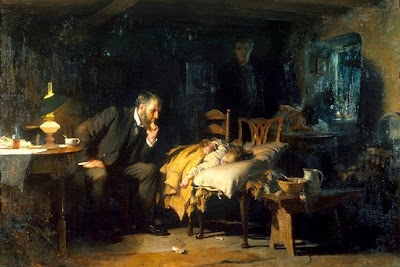Sir Luke Fildes lost his eldest son Phillip on Christmas Eve 1877 while a doctor spent a compassionate vigil at the child’s side. In commemoration, Sir Fildes painted “The Doctor” (above) in 1891 to depict “the physician in our time.”
This same painting was used by the American Medical Association (AMA) in 1949 to stop President Harry Truman in his attempt to nationalize health care. The message was “Keep Politics Out of This Picture.”
The AMA can’t use this picture or tactic this time around. Things have changed too much.
Some of us who’ve lived long enough can actually recall how doctors once did make house calls and could even be reached on weekends and evenings for emergencies. (Today, you get a voice recording commanding you to “Dial 911.”)
To say the least, we’ve come a long way in our medical care, and in one sense Obama is correct–the system is broken if you’re looking for compassion and home visitations.
But it’s not really broken, just adapted to a new reality. We’re now a nation of 300 million people with nowhere nearly enough doctors to even treat all of us, let alone make house calls (though some still do and swear by it).
Medical care is now like visiting an auto mechanic. “Doc, it hurts here.” “Let me take a look.” A few small probes and examinations later, and the doctor is ready. “Fortunately, nothing is broken. I’ll prescribe you some painkillers. You should be fine in a few days.”
Okay, so I’ve simplified things here a bit (I left out the two sets of x-rays and follow-up MRIs), but the general picture of “sick care” in America is just that. It’s like taking your car into the shop, except it’s your body–and your life.
Paucity of time and doctors can account for our new reality, but the biggest contributing factor to what Obama calls our “broken” health care system is Medicare and Medicaid.
Since most doctors won’t accept the payment structure of Medicaid, leaving that to emergency rooms, your family doctor is modelling his or her practice on the Medicare payment structure–the more procedures he or she can perform, the more the office can bill for your visit. (“I also notice your car’s belts are getting worn. We’d better replace those for $125 before you get stuck on the freeway.” Get the analogy?)
So, the next time you hear politicians’ bemoaning our “broken” health care system, remember it’s only broken because Medicare made it into an assembly-line industry, with each nut, bolt, worker, and procedure along the line being billed for and paid separately.
This is the typical pattern with government: First break it, then blame it on others and come rushing to the rescue to garner votes for the next election, reality be damned.
Politicians just created the housing and credit crises by pushing banks to create “affordable housing.” Now they’re blaming the bankers and everyone one else in the Fannie Mae/Freddie Mac food chain and claiming to have the solution with “more regulation.”
If they really wanted to “fix” health care, all they have to do is fully fund Medicare and come up with a payment structure that rewards healthful results rather than procedures. That’ll stop the cost-shifting to private insurers and build some efficiencies into the system.
Instead, they’ll give us more regulation (read “rationing”) and expand Medicare, the very cause of the crisis in the first place.


